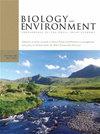What have we learned from over two decades of monitoring riverine nutrient inputs to Ireland's marine environment?
IF 0.6
4区 环境科学与生态学
Q4 ENVIRONMENTAL SCIENCES
Biology and Environment-Proceedings of the Royal Irish Academy
Pub Date : 2022-01-01
DOI:10.3318/BIOE.2016.23
引用次数: 9
Abstract
Abstract:Excessive nutrient loading to the marine environment from different sources and pathways, including rivers, has led to nutrient over-enrichment and the phenomenon of eutrophication in estuaries and coastal waters. The systematic monitoring of riverine nutrient inputs to Ireland's marine environment began in 1990. Over this period there has been a large reduction in nutrient inputs with loads of total phosphorus, total ammonia and total nitrogen decreasing by 71.8% (4,716 tonnes), 77.3% (5,505 tonnes) and 39.0% (59,396 tonnes), respectively. The largest reductions, particularly in total phosphorus and total ammonia, were seen in the main rivers discharging to the Celtic and Irish Sea coasts, with smaller or no reductions in rivers discharging along the western and north-western Atlantic coast. The reductions indicate the success of measures to reduce nutrient loss but also the disproportionate reduction in phosphorus over nitrogen. The ratio between nitrogen and phosphorus loads has increased by 2.5% per year and by as much as 4.1% per year for discharges to the Celtic Sea. As a consequence, the stoichiometric N:P ratio of river inputs to the Celtic Sea has more than doubled. The potential for this disparity to create a nutrient imbalance in downstream estuarine and coastal waters is discussed.我们从20多年来对爱尔兰海洋环境的河流养分输入的监测中学到了什么?
摘要:包括河流在内的不同来源和途径对海洋环境的养分负荷过大,导致河口和沿海水域的养分过度富集和富营养化现象。对流入爱尔兰海洋环境的河流养分的系统监测始于1990年。在此期间,养分投入大幅减少,总磷、总氨和总氮的负荷分别减少了71.8%(4,716吨)、77.3%(5,505吨)和39.0%(59,396吨)。最大的减少,特别是总磷和总氨,出现在流向凯尔特和爱尔兰海岸的主要河流中,而沿着大西洋西部和西北部海岸的河流减少较少或没有减少。这些减少表明减少养分损失的措施取得了成功,但也表明磷比氮减少得不成比例。氮和磷负荷之间的比率每年增加2.5%,每年排放到凯尔特海的比率高达4.1%。结果,河流输入凯尔特海的化学计量氮磷比增加了一倍多。讨论了这种差异在下游河口和沿海水域造成营养不平衡的可能性。
本文章由计算机程序翻译,如有差异,请以英文原文为准。
求助全文
约1分钟内获得全文
求助全文
来源期刊
CiteScore
1.10
自引率
0.00%
发文量
6
审稿时长
>36 weeks
期刊介绍:
The journal aims to offer a broad coverage of the subject area, including the following:
- biology and ecology of the Irish flora and fauna
- microbial ecology
- animal, plant and environmental physiology
- global change
- palaeoecology and palaeoclimatology
- population biology; conservation of genetic resources
- pollution and environmental quality; ecotoxicology
- environmental management
- hydrology
- land use, agriculture, soils and environment.
Submissions on other relevant topics are also welcome, and papers of a cross-disciplinary nature are particularly encouraged.

 求助内容:
求助内容: 应助结果提醒方式:
应助结果提醒方式:


